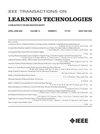OrientaTree:定位教育定向运动的移动工具
IF 4.9
3区 教育学
Q2 COMPUTER SCIENCE, INTERDISCIPLINARY APPLICATIONS
引用次数: 0
摘要
定向运动作为一种安全有效的运动工具和一项娱乐活动,长期以来一直被用于体育教学中,因为它对感知运动能力有公认的好处。它还有助于获得除体育以外的多个领域的技能,如地理、数学或生物。许多教师利用定向运动的这种跨学科性质,在每个控制点进行教育任务,并使用地理定位和移动设备来避免与建立和拆除物理电路相关的繁琐任务。然而,允许这种地理定位定向教育活动的系统在定向运动元素的实施或教师配置和监控能够适应其学习目标的学习环境的教育可能性方面存在一些局限性。为了应对这些挑战,本文提出了一组设计要求,以创建地理定位的定向教育系统,并根据上述要求创建了一个移动工具OrientaTree。通过特征分析和涉及5名教师和115名学生的试点研究,对“东方树”的原型进行了评价。评估结果提供了证据,表明OrientaTree克服了其他评估方法在开展地理定位定向运动教育方面的局限性。然而,它可以得到改进,允许更多的配置功能,允许教师更好地调整活动,以满足他们的学习目标。本文章由计算机程序翻译,如有差异,请以英文原文为准。
OrientaTree: A Mobile Tool for Geolocated Educational Orienteering
Orienteering has long been used in physical education due to its recognized benefits for perceptual-motor capacity, as a tool for safe and efficient movement and as a recreational activity. It also helps in the acquisition of skills in multiple domains besides physical education, such as geography, mathematics, or biology. Many teachers use this interdisciplinary nature of orienteering, complementing it with educational tasks at each control point, and using geolocation and mobile devices to avoid the cumbersome tasks related to the setting up and dismantling of physical circuits. However, the systems that allow this kind of geolocated educational orienteering activities have some limitations in their implementation of the elements of orienteering or in the educational possibilities for teachers to configure and monitor learning situations that can adapt to their learning goals. To address these challenges, this article proposes a set of design requirements to create geolocated educational orienteering systems and a mobile tool, OrientaTree, created following the said requirements. A prototype of OrientaTree has been evaluated by means of a feature analysis and a pilot study involving five teachers and 115 students. The results of the evaluation provide evidence that OrientaTree overcomes the limitations of alternative reviewed approaches to conduct geolocated educational orienteering activities. However, it could be improved to allow more configuration capabilities to permit teachers to better adapt activities to their learning goals.
求助全文
通过发布文献求助,成功后即可免费获取论文全文。
去求助
来源期刊

IEEE Transactions on Learning Technologies
COMPUTER SCIENCE, INTERDISCIPLINARY APPLICATIONS-
CiteScore
7.50
自引率
5.40%
发文量
82
审稿时长
>12 weeks
期刊介绍:
The IEEE Transactions on Learning Technologies covers all advances in learning technologies and their applications, including but not limited to the following topics: innovative online learning systems; intelligent tutors; educational games; simulation systems for education and training; collaborative learning tools; learning with mobile devices; wearable devices and interfaces for learning; personalized and adaptive learning systems; tools for formative and summative assessment; tools for learning analytics and educational data mining; ontologies for learning systems; standards and web services that support learning; authoring tools for learning materials; computer support for peer tutoring; learning via computer-mediated inquiry, field, and lab work; social learning techniques; social networks and infrastructures for learning and knowledge sharing; and creation and management of learning objects.
 求助内容:
求助内容: 应助结果提醒方式:
应助结果提醒方式:


